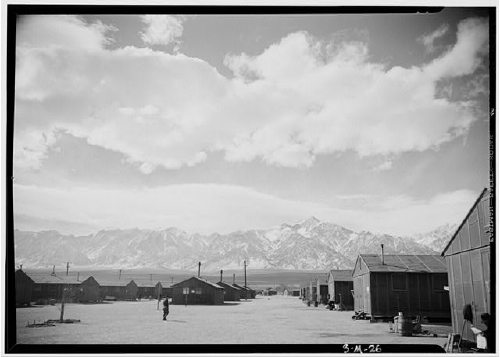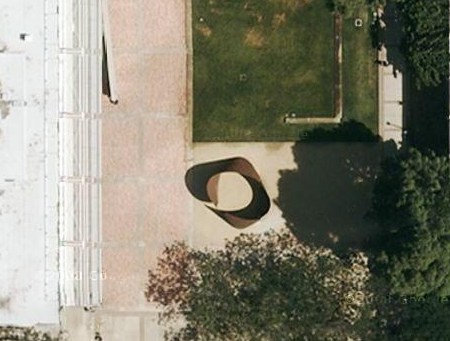
Apparently, with all the digital technology and whatnot, they hold onto that stuff at Bloomberg News, even if you’re not indicted immediately.
Art Dealer Charged With Stealing $88 Million [image: chip east/bloomberg news, photographed in 2007]
Category: etc.
I’m Just A Bill

But not that Bill.
The Obamas Get Up Close and Personal In DC [nyt’s automated related link generator]
On A More Conceptual Approach To Hair Loss
I’m not interested in the so-called PC aspects of discussing hair loss. The parody of an apologetically sensitive term like “follicularly challenged” is still of a piece with the negative connotation baked into the term, “hair loss” itself. Same with the self-affirming bald pride nonsense of the “God only made a few perfect heads. The rest he covered with hair.” variety with gets cross-stitched onto too many pillows.
I’m interested in the seemingly universal, unquestioning acceptance of the hair loss [sic] paradigm. Now there’s obviously a strong, pro-bald paradigm at work as well, thanks in large part to Michael Jordan and his shaved head.
But when it’s discussed at all, the language and perception of hair loss is consistently negative. It’s a loss, not “scalp expansion.” “Hairlines recede,” foreheads don’t “advance.” At best, it’s a “problem” that guys “deal with” or “accept.” At worst, they deny it, fight it, hide it. Whether it’s a transplant, a toupee, or a combover, the results are always unsatisfactory, or at least aesthetically sub-optimal. And yet, does anyone ever say anything to the guy about his self-inflicted hair mistake? Not likely. Whether it’s someone else’s or our own, hair loss is usually slow enough that most people pretend it’s not happening and move on.
When I was a little boy, my paternal grandfather wore a toupee. It was thick, dark, and carefully styled–immediately recognizable to the most casual viewer. To me, the most remarkable thing about it was that he’d take it off when he got home, like a hat. He placed it upside-down on the coffee table, where it looked Meret Oppenheim-esque, a furry candy bowl with a strip of double-sided tape running down the center. I don’t remember anyone in our family or beyond ever talking about it, or even acknowledging its existence. What my grandfather’s motivations were for wearing it, and how it related to his perception of himself and the image he sought to project once he stepped out his door, I don’t know. I wish I did.

Actually, what I really wish was that I had the guts and presence of mind to take a conceptual, dispassionate, but engaged view of hair loss. Specifically, I wanted to get–OK, I wanted to see someone get–a tattoo of his hairline.
The idea came to me in 1995, soon after seeing Alix Lambert’s photograph of a tattooed head on the cover of Open City magazine. Wouldn’t it be awesome, I thought, for a guy to periodically trace a tatoo along his hairline as soon as he saw that it was changing? Add a new line maybe once or twice a year. As his hairline moved back, his tattoo would grow, and it would take on some kind of chronotopographical shape, somewhere between ripples in the sand and hollows in a sandstone cliff. Like carving notches in a growing kid’s door jamb, the tattoo would become a portable, integral memento of a passage of the man’s life.
Obviously, as my own tattoo-less head proves, there are complications to such a project. The generally negative perception of hair loss means that a guy’s denial and anxiety are strongest when it starts; you’re ignoring your hairline is shifting at the exact moment you’d need to start documenting the migration. You wash your face, and your muscle memory fails to take into account your extra forehead. But it works out because when you shampoo, you still try to lather up the top of your head the most, even though that’s not where most of your hair is anymore.
Tattoos have become far more popular and destigmatized since 1995, but facial/head tattoos still seem to carry a taboo that can affect acceptance among the mainstream culture. A guy with a bad hair transplant could become Vice-freaking-President in this country, but a guy with a conceptual scalp tattoo would be unemployable.
A corollary project would be a conceptual approach to hair transplants that rejects the default “naturalistic” aesthetic which is the unquestioned ideal. I remember seeing a guy in that first Barnes & Noble on Broadway, up from Zabar’s, an Indian/Asian guy with a vast, smooth head with a tiny fringe and like ten hair plugs on top. It’s like he was determined to get something done, but he only had money enough for a dozen plugs. And yet some doctor took his money and arranged his plugs in bowling pin formation on the top of his endlessly bald head.
But what if a guy laid out his hair transplants in a design? A spiral, a fan radiating from his now-invisible widow’s peak? A lightning bolt? The Nike Swoosh? Any one of the thousands of designs that guys get shaved into their fades every day on Astor Place–only in reverse and permanent?
Getting Into Trouble With The NY Times
The report this weekend–from Apartment Therapy–about Apartment Therapy getting a takedown notice from the NY Times legal department for unauthorized use of the Times’ IP reminds me of the Apartment Therapy story from June 2004 about Apartment Therapy getting an angry call from the NY Times Home Section writer Marianne Rohrlich.
Rohrlich was pissed at AT’s weekly replication of the Times Home Section content, photos, links and such. AT’s response was to aw shucks about what big fans they are, and to tout the amount of traffic they’re driving to the Times’ site:
“Did it occur to you that it is not right to just LIFT other people’s work?” she asks me. (“Do you know what blogging is?” I want to ask.) “Our legal department is going to be calling you.”
Calling us! Legal department! Whoa!
I had a Shawn Fanning moment. Is this Napster 2004? Are we in trouble?
Now Matt and Andy are on the case, The Case of the Fishy DMCA Martyr Ploy.
DMCA Takedown notice: The NYTimes goes to war, wants to shut us down [at]
Apartment Therapy on Getting Into Trouble [at]
Mark Ravalomanana Of The Antananarivo Ravalomananas
On the way to the gym, I was really enjoying a news report on the radio about the political unrest in Madagascar. [Capital: Antananarivo, (AN-tan-uh-Na-REEV]
The about-to-be-deposed president must be pretty bad; why else would they give up such an awesomely named leader as Marc Ravalomanana? [RAH-vel-oh MUH-nuh-nuh] Makes me wish I’d been listening to Madagascan radio the last couple of years.
Incidentally, the demonym [!] for Madagascar is not Madagascan, but Malagasy. Madagascan applies to the island or country, but not to the people. Demonym=populace + name.
Ensure Is George W. Bush’s Blue Gap Dress
Like everyone else in the country, I was glued to the screen September 11th, 1998, scrambling to download the massive Independent Counsel’s Report, aka the Kenneth Starr Report, from a still-scrawny Internet. I finally printed my copy in time for dinner, and my colleague from work and I pored over it at a sidewalk cafe near Dupont Circle, where we had traveled for a client meeting.
At the time, we were advising a group of entertainment and mall development companies on the creation of a startup, the purpose of which was to create the definitive platform for celebrity-driven retail. In other words, monetizable, industrial-scale product placement.
Which is why, while reading parts of the Starr Report out loud to each other, I had one of the lesser epiphanies of my life. I exclaimed to my colleague that this, the Kenneth Starr Report, was proof of the concept. After all, what brand was on every American’s mind that night? Exactly, Gap. the maker of Monica Lewinsky’s blue dress. I resolved right then to register the domain kennethstore.com as soon as I got back to my hotel. Which is what I did.
I proceeded to post the full text of the Starr Report, interspersed with illustrations and links–soon to be massive affiliate revenue producers, I’m sure–of the brands and products mentioned in the report: Gap, Ritz Carlton, Bic Pens. Actually, that was about it.
Ken Starr turned out to be no Bret Easton Ellis, and his report was no American Psycho. Also, I was too busy to ever format the pages for easier online reading, so there were two giant pages of text, each more than a hundred printed pages long. [The Library of Congress has formatted the IC Report quite nicely, I think, though there are no Amazon Associates links.] Also, neither Gap, nor Bic, nor much of anything else was really available for product-level linking and shopping in 1998, so while the concept was pure, and the execution wanting, the timing was also a bit early.
Oh, how times have changed. The New York Review of Books has published excerpts from a confidential 2007 report, ICRC Report on the Treatment of Fourteen “High Value Detainees” in CIA Custody, presented by the International Committee of the Red Cross to senior US intelligence officials over two years ago. The report methodically lays out the ICRC’s findings from interviews at Guantanamo Bay with presumed terrorist leaders, and declares that US imprisonment and interrogation tactics “constituted torture” and “cruel, inhuman or degrading treatment.” Mark Danner’s article on the report is an agonizing, outrage-inducing must-read.
But maybe there’s a silver lining, if not in terms moving actual product, at least in terms of brand awareness? Here’s Al Qaeda administrator Abu Zubaydah describing his first interrogations at a secret CIA base in Thailand:
I was given no solid food during the first two or three weeks, while sitting on the chair. I was only given Ensure [a nutrient supplement] and water to drink. At first the Ensure made me vomit, but this became less with time.
And then describing a later torture session, possibly in Afghanistan:
I was then made to sit on the floor with a black hood over my head until the next session of torture began. The room was always kept very cold.
This went on for approximately one week. During this time the whole procedure was repeated five times. On each occasion, apart from one, I was suffocated once or twice and was put in the vertical position on the bed in between. On one occasion the suffocation was repeated three times. I vomited each time I was put in the vertical position between the suffocation.
During that week I was not given any solid food. I was only given Ensure to drink. My head and beard were shaved everyday.
I collapsed and lost consciousness on several occasions. Eventually the torture was stopped by the intervention of the doctor.
Here’s Walid Bin Attash, a Yemeni involved with planning US embassy bombings in Africa and the attack on the USS Cole, describing his treatment after capture in 2003:
On arrival at the place of detention in Afghanistan I was stripped naked. I remained naked for the next two weeks. I was put in a cell measuring approximately [3 1/2 by 6 1/2 feet]. I was kept in a standing position, feet flat on the floor, but with my arms above my head and fixed with handcuffs and a chain to a metal bar running across the width of the cell. The cell was dark with no light, artificial or natural.
During the first two weeks I did not receive any food. I was only given Ensure and water to drink. A guard would come and hold the bottle for me while I drank…. The toilet consisted of a bucket in the cell…. I was not allowed to clean myself after using the bucket. Loud music was playing twenty-four hours each day throughout the three weeks I was there.
Khalid Shaikh Mohammed was captured in Pakistan. Here he is talking about his interrogation:
During the first month I was not provided with any food apart from on two occasions as a reward for perceived cooperation. I was given Ensure to drink every 4 hours. If I refused to drink then my mouth was forced open by the guard and it was poured down my throat by force…. At the time of my arrest I weighed 78kg. After one month in detention I weighed 60kg.
I can see it now: “How I lost 40 pounds–and kept it off!–thanks to Ensure and the CIA Diet!”

US Torture: Voices From The Black Sites by Mark Danner [nybooks.com]
Ensure Plus Complete Balanced Nutrition Drink, Ready to Use, Creamy Milk Chocolate Shake, 24-8 Fluid Ounce Bottles, just $49.99! [amazon.com]
German Bandstand
Holy smokes, we have seen Sprockets, and they are US.
And all this time I thought the weird-awesomest Monks were the guys publishing Monk Magazine from their motor home. This reminds me of the Pink Floyd track over the opening credits of Zabriskie Point. [via south willard]
Announcing The Establishment Of The greg.org Home For Unwanted Gerhard Richters
Pet Shop Boys – Love Etc. (HD) [youtube via andrew sullivan]
For the moment, “Love etc.” is playing largest on the PSB’s homepage [petshopboys.co.uk]
Out Of The Bubble

Every time I log in to check my eBay links, I’m like, “Obama!”
See how he embraces John McCain’s strategy for the economy with no pride of authorship?
Did I Say Japanese Internment Camps? I Meant CCC Happy Camps!

Another thing that caught me off guard looking through piles of photos from the Civilian Conservation Corps, was the camps. My interest in the CCC didn’t come from the New Depression unfolding around us, but from learning over Christmas that while he was in the CCC, my grandfather helped build the Topaz Relocation Center, the Utah internment camp in which Japanese-Americans were interned during WWII.
That Japanese Americans were forced to live in “tar paper-covered shacks” of military design set up in remote, harsh locations is unrefutable evidence of the camps’ punitive, prison-like conditions and an integral element of the entire internment camp narrative.
But what I didn’t realize was that is exactly how participants in the CCC lived, too. The image above, cropped from the official photo of Callao Camp in Juab County, just north of Topaz.
Compare it to Ansel Adams’ photo of the barracks at Manzanar below, from the Library of Congress:

Of course, it doesn’t minimize the injustice of being forced to abandon your home and possessions, then being imprisoned in the desert by your own government because of your race. But–and I know it’s hard to have a “but” after a sentence like that–but I have to imagine that the seven-plus-year history of the CCC, along with the experience of millions of Americans who participated in it, along with the Depression itself, had a formative influence on how the internment camps were perceived at the time.
What would public reaction be today if thousands of Pakistani-Americans were ordered to report to a fenced-off city made of FEMA trailers? Would we be outraged at the outrageous violation of their constitutional and human rights, or would we say, in the wake of Katrina, Ike, and waves of foreclosures, “Hey, what’s the big deal? It’s not a prison”?
Art & Fear by Bayles & Orland
Whether it’s right or not, this book sounds fantastic:
Making art provides uncomfortably accurate feedback about the gap that inevitably exists between what you intended to do, and what you did. In fact, if artmaking did not tell you (the maker) so enormously much about yourself, then making art that matters to you would be impossible. To all viewers but yourself, what matters is the product; the finished artwork. To you, and you alone, what matters is the process: the experience of shaping that artwork.
Art & Fear, by Peter Bayles and Ted Orland [via kottke and kk]
Georgia Republican Saying Arts Workers Aren’t “Real People” Hits Nerve
From a Boston Globe article, “Stimulus funding for arts hits nerve”:
Representative Jack Kingston, a Georgia Republican, wants to transfer the proposed NEA funding to highway construction. He failed to get the House to vote on his proposal, so he is now trying to get on the conference committee that will determine the fate of the funding. “We have real people out of work right now and putting $50 million in the NEA and pretending that’s going to save jobs as opposed to putting $50 million in a road project is disingenuous,” Kingston said in an interview yesterday, adding the time has come to examine all of NEA’s funding.
It’s funny how, a few months ago, a city’s economic viability was measured by its ability to attract and keep workers in the “creative economy,” a definition which has the arts as a core, but extends far beyond the narrowestm, NEA definition of the term. And museums and other cultural institutions always made the case for themselves by demonstrating the high ROI that every dollar spent on culture generated for the local economy.
And where is any of this analysis and advocacy now, when at least one congressman says arts workers aren’t even “real people,” and shouldn’t be subsidized by the government at all? This from a politician who defines his district by its [government-funded] military base and its relevance to cultural production? [Fourth of four points: “The First District has also a been a background for top films including Academy Award Winning Best Picture Forrest Gump…”]?
I thought the $50 million stimulus proposed for the NEA was embarrassingly low, and I expected arts institutions to be contacting their congressional delegations to explain their supposedly dire financial situations, and umbrella organizations would make the case for emergency stopgap funding to keep performing arts organizations alive until the economy improves. Where has that been?
Dana Gioia, a poet who was NEA chairman until last month, recalled that when top Roosevelt aide Harry Hopkins was asked why the government wanted to hire so many artists and writers, he replied, “Hell, they’ve got to eat just like other people.”
Gioia, reflecting on that comment, said, “As far as I’ve heard, nothing has changed about the dietary needs of artists.”
Gee, with powerful, articulate advocacy like that, I guess I needn’t have worried.
Stop Me If You Think That You’ve Heard This One Before
Priceless.
“I have a strange and unpleasant announcement to make,” host Dave Hill, a comedian…announced. “There are too many women and not enough men. We’re not sure what to make of this, but we have to close the registration to women.”
…
“Is this for real?” our female friend wrote in a text after being denied a spot. “The girl with the Smiths tattoos got turned away from Smiths speed dating?”
– from Adam Martin’s coverage of Heaven Knows I’m Miserable Now, a Smiths fan speed dating event in Greenpoint last week, for New York Magazine. [nymag via tmn]
Richard Serra Sculptures On Google Maps

The whole thing about the only human construct you can see from space is the Great Wall of China will be amusing to people growing up in the Google Maps era, where you can’t hide anything from the satellite’s surveilling eye. It’s the geospatial equivalent of explaining TV before remotes and cable: it’ll just make you sound old.
So kudos to Richard Serra for being ahead of the curve [no pun intended] on making work that turns out to be well-suited for viewing from our new conveniently God-like vantage point.
I started to make a list with the Torqued Ellipse in front of Glenstone, Mitch Rales’ foundation in Potomac, and the suggestion from Guthrie of T.E.U.C.L.A., a torqued ellipse in the Murphy Sculpture Garden behind the Broad Art Center at UCLA, described at its installation in 2006 as “the first public work by sculptor Richard Serra installed in Southern California.”
And that reminded me that the Broads have had a Serra titled No Problem in their backyard for a while, which, thanks to Google Maps, is now public. Searching for that image led me to pmoore66’s collection of bird’s eye view Serras around the world at Virtual Globetrotting. If you count Robert Smithson’s Amarillo Ramp, which he helped complete after Serra Smithson’s death [!], pmoore66 has sighted 44 Serras around the world using either Google Maps, or Microsoft’s Bird’s Eye View, plus another four shots on Google Streetview. [Here are the search results on Virtual Globetrotting for “Richard Serra”, but that link looks a little unstable.]

With more than 1,700 entries so far, pmoore66 appears to be almost single-handedly pinning down the modernist canon for architecture and outdoor sculpture. This warrants some looking into. Stay tuned.
The more oblique angles of birds-eye-view seems to suit Serra’s sculptures better, and they remind me of a series of little desk tchotchke-sized versions of monumental sculptures called minuments that I saw in the ICA London bookshop a few years ago. As soon as I can figure out how to get Google to stop spellchecking for me, I’ll get the artist’s name.
No, The Other Greg Allen
Greg Allen’s 25 Rules For Creating Good Theater [neofuturist.org via x-reference]
